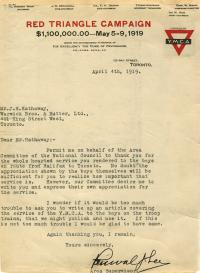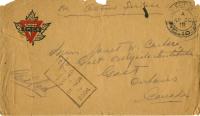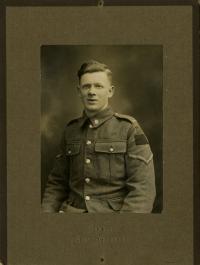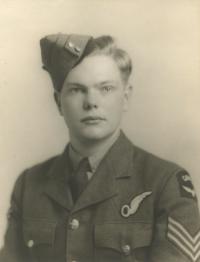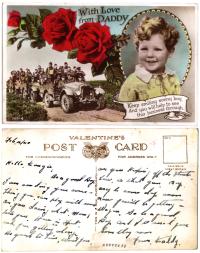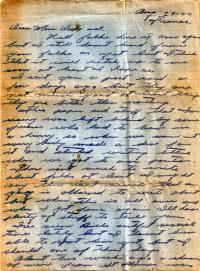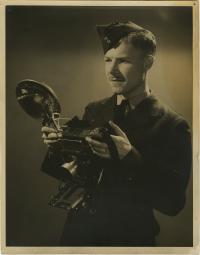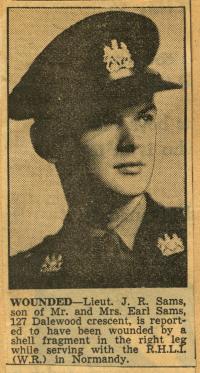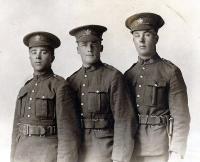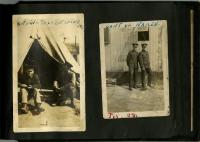Scrapbooks
Special Troop Train No.8
Mr. J.H. Hathaway of the Y.M.C.A. provided assistance on a troop train from Halifax to Toronto following demobilization. The group travelling on troop train No.8 was so grateful for his service that they sent Mr. Hathaway a letter with their signatures, and he also received praise from the Y.M.C.A.
Carter Family
Soldier Robert G. Carter of the 7th Battalion CEF wrote to his brother Fred Carter in 1914, from the Valcartier military camp in Quebec, before he died overseas of spinal meningitis on 26 March, 1915. His sister, Janet Carter, later reached out to any soldier in the No.1 General Hospital B.E.F. in 1915, and received a response on behalf of Private J. Clements. She also received correspondence in 1918, from a former student, gunner R. Waring. Her life was celebrated in 1975, as a member of the Waterloo County Hall of Fame at Doon Pioneer Village.
The life of Edward William Button
Edward William Button was born in Sittingbourne, Kent, in April 1892, and emigrated to Canada in 1913 at the age of 21. In January 1916, he enlisted in the 111th Battalion of the CEF.
An airman's keepsakes
John Bridgman of Roseland, Ontario, joined the Royal Canadian Air Force in 1943 and qualified as a bomb aimer at #9 Air Observer School in St Johns, Quebec. Amongst his wartime souvenirs are a certificate indicating that he had completed a tour of operations and aerial photographs taken on some of the bombing raids in which he participated.
From Hamilton to war
John “Jack” Smith was born in Scotland in 1906 and came to Canada as a teenager. He enlisted early in the Second World War, serving in the 5th Field Ambulance of the Royal Canadian Army Medical Corps. While he was overseas, he sent snapshots and other souvenirs of his travels to his family in Hamilton, Ontario, to show them the more mundane parts of serving in the army: field exercises, barracks life, an inspection by the King and Queen, and the surroundings in Spitzbergen, Russia, where he was posted for a short time in 1941.
Memories of a soldier son
Patrick McDermott left his home in Woodstock, Ontario, to enlist in the Canadian Army, and eventually served with the Black Watch (Royal Highland Regiment) of Canada. He was killed in action in September 1944, and buried in Bergen-op-Zoom Canadian War Cemetery in the Netherlands. After the war, his family saved these few mementos of his time in uniform.
Ron Laidlaw's Keepsakes
Ron Laidlaw, longtime resident of London, Ontario, was a war photographer with the RCAF during the Second World War. He was, allegedly, the first Allied photographer to enter Bergen-Belsen concentration camp and among the first to enter the newly liberated city of Paris. He brought back with him a collection of Nazi artifacts and Adolf Hitler collector cards, as well as official photos that he took in England, France, Holland, and Germany.
Joe Sams' family scrapbook
Joseph Reed Sams enlisted in 1943 and fought with the Royal Hamilton Light Infantry. While he was at the front, his family kept a scrapbook of newspaper articles concerning the major battles in which they believed he had fought. Throughout the scrapbook are items that are more personal, such as the telegram informing the family that Sams had been wounded. Other interesting items, added after he had returned home are a Nazi badge, Sams' campaign ribbon, and a fifty-Reichsmark bill.
Arthur Wylie - from infantryman to doctor
Walter Arthur Wylie (on the right in this photograph) was a student at Yorkton High School in Saskatchewan when he enlisted in the 196th (Western Universities) Battalion in March 1916. He served at the front for seventeen months with the 46th Battalion and was wounded early in the Hundred Days Offensive. Wylie returned to Canada in 1919, to marry Blanche Robinson and begin a long career as a doctor. He treasured these souvenirs from his time in the CEF, and also kept diaries of his wartime experiences (currently being digitized).
An album of the Canadian Army Medical Corps
This album, from London, Ontario, features many unidentified photos and images with handwritten captions. Among the identified subjects are Mr. and Mrs. Dechtro, Miss Frances McCabe as a child, Mr. Frank Lafleur, Mr. Thomas Cat, Mrs. Emma Seven Oaks and sister, Lydia Jahnke, Mrs. Grace Raubolt and son, Miss Agnes Davies, Mr. Nick Poulas, Sergeants McFee and Shaw, “Frenchy and Scotty,” George Latimer, Sergeant Major McDonald, Harriet and Isabell Raubolt, Mr. and Mrs. Higginson, the “Riot Squad” in London, Isabell Powell, Sergeant D.G.

